Rules for growing zucchini seedlings
Correctly sprouted squash seedlings produce strong bushes, which in the future will give a bountiful and tasty harvest.
- Seed preparation
- How to speed up the germination process
- Sowing dates
- Growing rules
- Soil preparation
- Choice of capacity
- Landing technique
- Conditions for successful germination
- Watering
- Fertilizers
- Illumination and temperature
- Picking
- Transfer to the site
- Further care
- Top dressing
- Prevention of diseases and pests
- Recommendations
- Growing up in the North
- Difficulties in growing
- Freezing sprouts
- Yellowing and wilting of seedlings
- Blackening of stems and foliage
- Conclusion
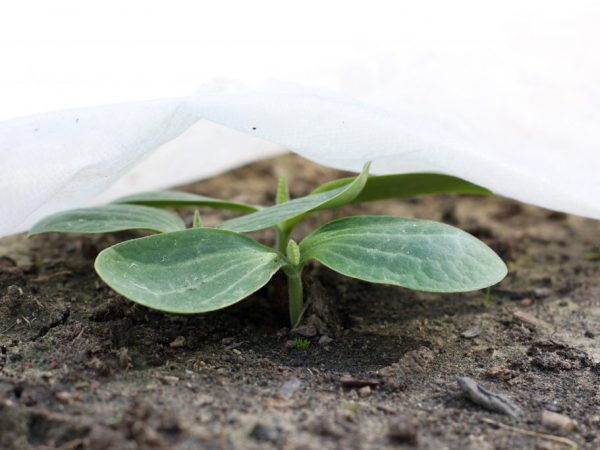
Rules for growing zucchini seedlings
Seed preparation
To germinate zucchini seedlings at home, you should use dense seeds, without yellowness, rot and mechanical damage.
They must first be etched. This manipulation will prevent the development of fungal and viral diseases on the bushes in the future.
There are several ways of processing:
- To prevent the appearance of a fungal infection, the seeds are placed in a tissue bag and immersed in well-heated water to a temperature of 50 °. Soaking time is 4 hours.
- You can also soak in a mixture of Gamair and Alirin-B. Take 1 tablet of each drug and dissolve in 1 liter of water. Procedure time - 10 hours.
- The drug Fitosporin-M has proven itself well. At room temperature, the seeds are soaked for 15 hours.
- Some gardeners resort to folk processing methods. Some use aloe juice, others use Kalanchoe juice diluted with water in a 1: 1 ratio. After soaking for 30 minutes, the seeds are thoroughly washed in warm water and dried.
Usually purchased seeds are sold already treated, and their additional processing can lead to a complete loss of germination. Processed seeds are brighter in color.
How to speed up the germination process
After pickling, the seeds are treated with special preparations to accelerate their germination:
- The simplest method is to soak the seeds in warm water (25 ° C) for 24 hours just before sowing.
- Some people choose to germinate seeds wrapped in a damp cloth. This takes about 10 days. For planting, the shoots must be 5-7 mm in length.
- Seed stratification by changing the temperature regime. First, the seeds are placed in a damp cloth and sent to the refrigerator (at 0 °) for 12 hours. Then the inoculum is removed and kept at room temperature for 6-8 hours. For high-quality stratification, several such procedures must be carried out within 3 days.
- Seed bubbling procedure. The seed does not need to be presoaked. It is immediately planted in a gelatinous mixture of starch and paste. For 200 ml of paste, 2 g of seeds are used. The seeds are mixed with paste. They are kept in such an environment for 6 hours and poured into the prepared sowing grooves.
- Also, seeds can be soaked in preparations that stimulate growth. Good for this is potassium humate, Epin, Zircon, a complex composition of trace elements.Soaking time from 8 to 20 hours. A solution of wood ash (1 tbsp. L. Substance per 1 l of water) also increases the germination of squash seeds.
Sowing dates
The time of sowing seeds at home depends on the region where this crop is grown.
Planting zucchini for seedlings in the middle lane - from April 20 to May 15 (there will be an early harvest of fruits). For the late, the optimal time is from 15 to 30 July.
If you plan to grow seedlings under a film, the seeds are planted 2 weeks earlier.
Growing rules
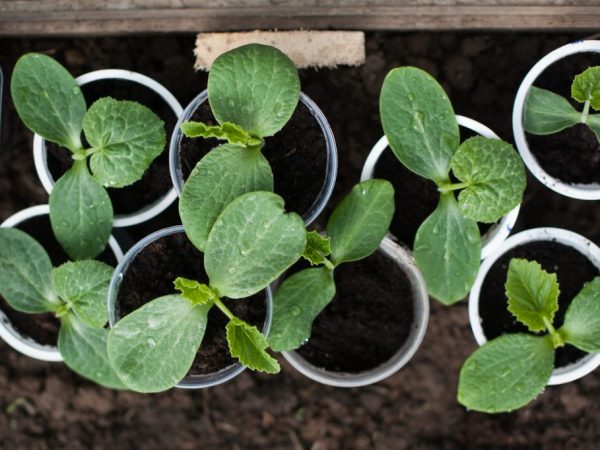
Seedlings appear in good lighting
To grow zucchini seedlings on the windowsill, you should choose a suitable place with good lighting:
- if you place it on the southern windowsill, then additional lighting will not be needed;
- on the north side, artificial lighting will be required;
- on the west or east side, seedlings should be provided with 10 hours of daylight.
During germination, it is important to ensure that there are no sudden changes in temperature and drafts in the room. In cold and unstable heat, seedlings may never break through the soil.
Certain conditions are required for the successful cultivation of seeds. To get strong and healthy shoots, you need to choose the right soil composition, capacity, feed the seedlings in time, water them and provide stable heat and light.
Soil preparation
For growing zucchini (or zucchini) through seedlings, the following is suitable: universal soil; specially prepared soil for garden vegetation; soil for planting pumpkin plants.
You can also prepare the soil mixture yourself. There are three options:
- Mix peat soil (50%), humus (30%), turf soil (20%) and semi-rotted sawdust (10%). To improve the composition, a little coarse sand can be added to the soil. Ammonium nitrate (5 g), phosphorus (10 g) and potassium salt (10 g) are added to a bucket of the prepared mixture.
- Many gardeners plant zucchini in a mixture of compost (humus) and turf. Both ingredients are mixed in equal parts. Phosphorus (10 g), wood ash (200 g), potassium salt (10 g) and a little river sand are added to a bucket of such a mixture.
- It is good to deepen the zucchini into a mixture of sand and peat.
Choice of capacity
It is best to plant zucchini in plastic or peat containers due to the intolerance of seedlings to the transplant procedure. After a dive, the seedlings may simply wither and die.
No less important are the dimensions of the landing container themselves: the optimal diameter (90-100 mm), the height - no more than 10 cm.
Some gardeners have gotten used to growing seedlings in homemade cups made from newspaper or any other practical material.
Landing technique
- the soil in the cups is abundantly irrigated from a spray bottle;
- deepen the seeds with the sprout up to a depth of 2-3 cm;
- Sprinkle the planted seedlings with a little warm water.
Conditions for successful germination
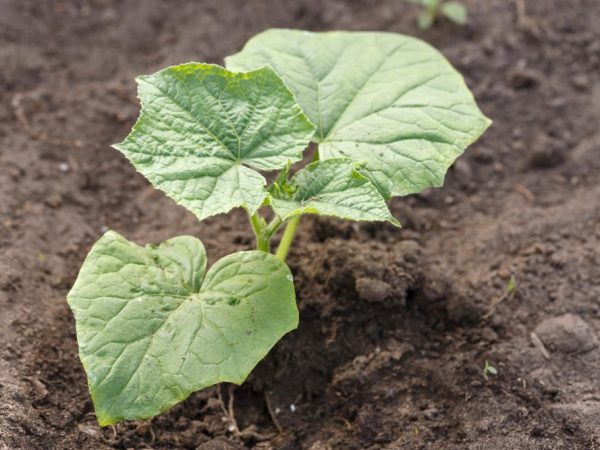
Seedlings need fertilization
In order for the seedlings to be ready for transplanting in open ground, they must be provided with some conditions.
Watering
For irrigation it is necessary to use only warm, settled water (23-25 °). When watering with cold water, you are unlikely to wait for the sprouts to appear.
Seedlings should be watered once every 10 days, since an excess of moisture can provoke the appearance of mold and rotting of seeds that have not yet hatched.
On hot days, water is often watered - once every 3-4 days to prevent the soil and seeds from drying out.
Fertilizers
The first feeding is carried out immediately after the mass appearance of sprouts, and this will take about 7-8 days from the moment of sowing.
For feeding, use the following solution: for 1 liter of water give 0.5 tbsp. l. phosphorus and urea. Instead of such a nutritional composition, you can use the ready-made Bud preparation.
The second meal is carried out 10 days after the first: ½ tbsp. l. wood ash is mixed with the same amount of nitrophoska and dissolved in a liter of water.
The prepared fertilizers are applied under each plant - no more than 1.5 tbsp. l.
Illumination and temperature
After sowing, the seeds must be provided with a temperature regime within 18-23 °.
As soon as the first shoots appear, the plantings are provided with different temperatures depending on the time of day:
- in the first 24 hours - 15-20 °;
- at night - 12-15 °.
Then the temperature is gradually increased by 2-3 °, the maximum mark is 25 ° during the day, 19 ° at night.
With severe overheating, you will not be able to accelerate the growth and development of seedlings, but only ruin it - the sprouts will become weak and wither.
Picking
This manipulation is carried out at the stage of transplanting plants into open ground, approximately 25-29 days after sowing the seeds.
The optimal planting time depends on the stage of plant development - at the same time, each copy should have at least 3 leaves.
Transfer to the site
Before planting zucchini seedlings in open ground, they are gradually accustomed to fresh air. Quenching is carried out a week before the planned landing.
First, the seedling boxes are taken outside and kept for several hours during the daytime, and brought indoors at night. 1-2 days before planting, the plants are left to spend the night outside.
The key to success in growing will be the correct planting scheme.
Do not plant too densely - so you should not expect a good harvest, and in solid thickets there is a high risk of diseases and parasites.
The optimal distance for semi-shrub and long-growing varieties is 70x90 cm, bush can be planted at a distance of 70 cm, keeping the same distance between rows. It should be deepened to a height of cotyledonous leaves. If the plants are buried below this part, there is a high risk of stem rot and plant death.
The landing technique consists of several stages:
- Pits are pulled out, spilled with warm, settled water.
- We plant the seedlings, carefully compact the soil around the thin stalks and spill it with warm water (1 liter of water is required for one instance). When watering, it is important that moisture does not get on the foliage.
- In the first weeks after planting, the seedlings should be covered with non-woven fabric or film overnight so that they do not freeze. Because with a lack of heat and sudden changes in temperature, tender and not yet matured sprouts can turn black and die. In the morning, when the air warms up, the shelter should be removed.
Further care
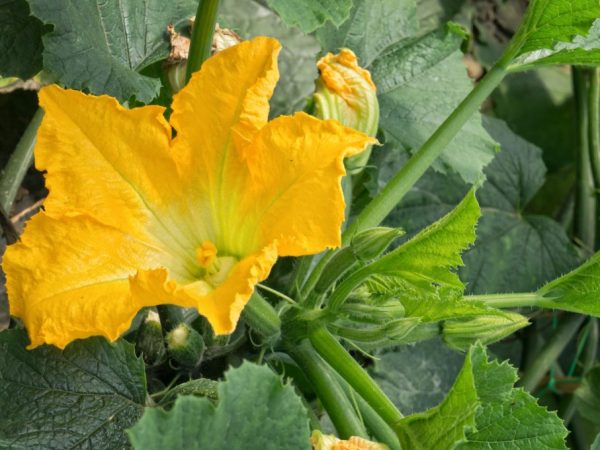
Zucchini should be watered with warm water
Plants planted in the garden need careful and timely care:
- Regularly watered with warm, settled water. In drought, the bushes are moistened every third day. In a rainy summer, plantings are watered as the soil dries.
- Loosening the soil after watering prevents the appearance of a crust on the surface and thereby protects young roots from drying out. You should also remove the weed in time, which takes away moisture and nutrients from the plants.
- Mulching with peat, last year's manure or garden soil prevents moisture evaporation. Mulch is applied after watering and loosening the soil.
Top dressing
For the entire season, the bushes should be fed several times.
To build up greenery (leaves and shoots), zucchini are fertilized with nitrogen-containing preparations 2 weeks after planting in the garden.
At the stage of formation of inflorescences and ovaries, plantings are fed with phosphorus and potassium, which increase the quality and quantity of the future harvest.
The best means for obtaining a bountiful harvest is the mitlider mixture: nitrophoska (6 kg), urea (1 kg), potassium sulfate (1 kg), magnesium sulfate (1 kg), molybdic acid (15 g) and boric acid (15 g).
Prevention of diseases and pests
To prevent the appearance of diseases and parasites, regular inspection of the bushes for infection, keeping the distance when planting plants and keeping the garden clean will help.
In case of damage to bushes with powdery mildew, spotting, mosaic or fusarium, weakly infected bushes are treated with fungicides, neglected specimens are removed and burned.
For aphids, spider mites, insecticides are used (Actellik, Fundazol or Aktaru). All treatments are carried out before the seedlings have bloomed and a month before the planned harvest.
Recommendations
- To obtain large fruits, remove excess inflorescences on the bushes. To improve bushiness in bush forms, pinch off the apical shoot. To attract bees, zucchini are irrigated with a weakly concentrated solution of honey in the early morning.
- To increase yields, it is important to pick the fruits on time and pick off the lower large leaves.
Growing up in the North
Despite the harsh climatic conditions of the northern zone and the short summer, gardeners still manage to successfully grow seedlings of zucchini, zucchini and pumpkin and get a good harvest.
Planting technique, soil selection and planting containers are the same as in other regions of our country.
The only difference is the timing of planting seeds. They are significantly shifted due to the peculiarities of climatic conditions - they are postponed to late April-early May.
Not all varieties are suitable for the northern zone; preference should be given to those varieties in which the growing season is about 50 days from the moment of sowing the seeds to harvest. Such varieties and hybrids must be highly resistant to a drop in air temperature.
After transplanting to the site, the seedlings must be covered with a film to prevent their freezing.
Difficulties in growing
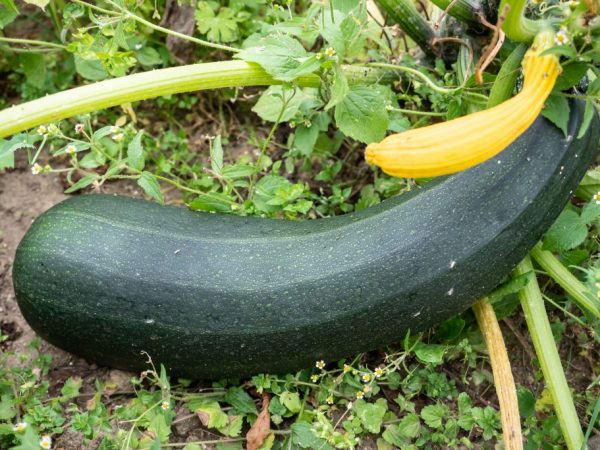
zucchini grow when properly transplanted into the ground
Growing marrow seedlings, gardeners often face many problems that lead to wilting, blackening and death of the sprouts.
Freezing sprouts
This is one of the most common causes of the death of young plants. At the onset of the slightest subzero temperature, moisture in the cells of stems and leaves is converted into ice.
After the temperature warms up, the ice does not have time to thaw, tearing the cells from the inside, as a result of which the plants die.
But do not despair - those specimens that were partially damaged can still be reanimated, the main thing is that the stem itself remains intact.
There are several ways to revive such seedlings:
Spray with cold water
Do this early in the morning, when the frost has not yet disappeared from the frozen zucchini. After irrigation, the seedlings must be shaded.
Any available material is suitable as shading - newspaper, cardboard or plywood.
After such manipulations, young sprouts will gradually thaw, which will save them from wilting and death.
Treat with drugs (antidepressants).
One of the best is Epin-extra. This tool increases the resistance of plants to adverse environmental conditions - frost, drafts and sudden temperature changes.
The entire aboveground part of the plants is treated, incl. and the underside of the leaves.
Then they take a break and after 10 days the procedure is repeated. And so on until the moment of complete restoration of frozen plants.
In 5 liters of boiled water dissolve 1 ampoule of the drug. For acidification, 1 tbsp is added to the solution. l. vinegar or a couple of pinches of citric acid.
After preparation, it must be used in two days.
Given the property of Epin to quickly evaporate under the influence of sunlight, the treatment should be carried out in the early morning or late evening.
Instead of Epin, you can use Zircon (1 ml of the drug is consumed per 10 liters of water). The frozen sprouts are processed four times with an interval of 10 days.
Application of complex fertilizers
To resuscitate plants damaged by frost and stimulate their growth, a complex composition of phosphorus (5 g) and nitrogen (4 g) can be added to the soil.
The quantity is calculated for a plot of 1 m².
Yellowing and wilting of seedlings
This phenomenon can be caused by several reasons - an overabundance or lack of fertilizers in the soil, acidification of the soil or a lack of moisture.
Therefore, before planting on the garden, it is important to choose the right area with loamy, slightly acidic soil, flavored with organic matter. It is also important to adjust the frequency of watering so that the plants do not suffer from a lack of moisture.
Fertilizers should be applied strictly according to the scheme indicated on the package.
Blackening of stems and foliage
This usually occurs when the seedlings are infected with black leg or other viral or bacterial infections.
To avoid infection of healthy specimens, patients should be immediately removed from the site, and then burned.
Conclusion
Growing marrow seedlings at home is a laborious process and requires some knowledge. Using the above instructions, you can easily and successfully grow strong sprouts and get a high-quality and abundant harvest of juicy vegetables from them in the future.

